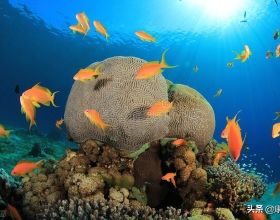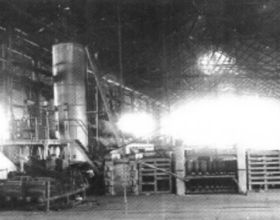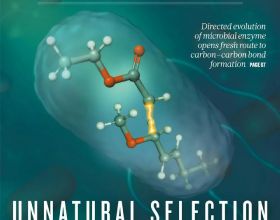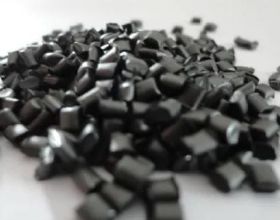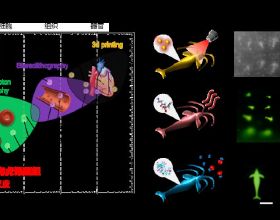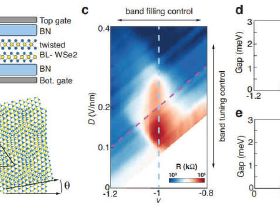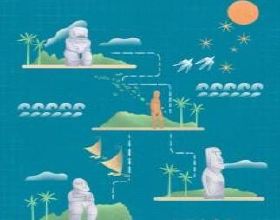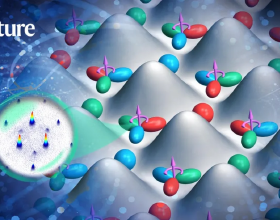編譯 | 未玖
Nature, 30 September 2021, VOL 597, ISSUE 7878
《科學》2021年9月30日,第597卷,7878期
天文學Astronomy
The importance of lake breach floods for valley incision on early Mars
早期火星湖泊決口洪水對河谷下切的重要性
▲ 作者:Timothy A. Goudge, Alexander M. Morgan, Gaia Stucky de Quay & Caleb I. Fassett
▲ 連結:
https://www.nature.com/articles/s41586-021-03860-1
▲ 摘要
早期火星的地表環境有一個活躍的水文迴圈,其中包括流動的液態水,塑造了河谷,填滿了湖盆。其中200多個湖盆充滿了足夠的水,足以衝破封閉的地形,造成災難性的洪水和出口峽谷的下切。
許多先前工作已經認識到火星上湖泊決口洪水對快速下切大峽谷的重要性;然而,在全球範圍內,河谷系統的形成原因通常被解釋為與分散式火星水文迴圈相關的更持久的河流侵蝕。
研究組證明了湖泊決口洪水的全球重要性,並發現它導致了早期火星至少24%的下切河谷侵蝕,儘管其僅佔河谷總長度的3%左右。湖泊決口洪水是導致早期火星河谷下切的主要地貌過程,這反過來影響了許多火星河谷系統的地形形態和隕石坑高地等更廣泛的景觀演變。
研究結果表明,在重建火星河谷系統的形成條件時,應考慮湖泊決口洪水的重要性。
▲ Abstract
The surface environment of early Mars had an active hydrologic cycle, including flowing liquid water that carved river valleys and filled lake basins. Over 200 of these lake basins filled with sufficient water to breach the confining topography, causing catastrophic flooding and incision of outlet canyons. Much past work has recognized the local importance of lake breach floods on Mars for rapidly incising large valleys; however, on a global scale, valley systems have often been interpreted as recording more persistent fluvial erosion linked to a distributed Martian hydrologic cycle. Here, we demonstrate the global importance of lake breach flooding, and find that it was responsible for eroding at least 24% of the volume of incised valleys on early Mars, despite representing only approximately 3% of total valley length. We conclude that lake breach floods were a major geomorphic process responsible for valley incision on early Mars, which in turn influenced the topographic form of many Martian valley systems and the broader landscape evolution of the cratered highlands. Our results indicate that the importance of lake breach floods should be considered when reconstructing the formative conditions for Martian valley systems.
物理學Physics
Non-Hermitian topological whispering gallery
非厄米拓撲耳語迴廊
▲ 作者:Bolun Hu, Zhiwang Zhang, Haixiao Zhang, Liyang Zheng, Wei Xiong, Zichong Yue, et al.
▲ 連結:
https://www.nature.com/articles/s41586-021-03833-4#Ack1
▲ 摘要
1878年,Rayleigh勳爵觀察到了一種非常著名的現象,即聲波在倫敦聖保羅大教堂彎曲的拱廊中蔓延傳播。
這些耳語迴廊波在一個封閉的環境中進行有效散射,幾乎沒有衍射,因此在超聲疲勞和裂紋檢測以及使用矽基微環對奈米顆粒或分子進行光學感測方面得到了應用。
研究組使用碳奈米管薄膜修飾的熱塑性棒製成的聲子晶體構建了一個拓撲迴廊絕緣體,透過電熱聲耦合作為聲波增益介質。
透過為活化棒設計特定的非厄米性諧振,研究組能夠打破耳語迴廊模式的手性對稱性,從而實現拓撲“激聲”模式與所需手性的外耦合。預計這些發現將促進無損檢測和聲學感測方面的進展。
▲ Abstract
In 1878, Lord Rayleigh observed the highly celebrated phenomenon of sound waves that creep around the curved gallery of St Paul’s Cathedral in London. These whispering-gallery waves scatter efficiently with little diffraction around an enclosure and have since found applications in ultrasonic fatigue and crack testing, and in the optical sensing of nanoparticles or molecules using silica microscale toroids. Here we construct a topological gallery insulator using sonic crystals made of thermoplastic rods that are decorated with carbon nanotube films, which act as a sonic gain medium by virtue of electro-thermoacoustic coupling. By engineering specific non-Hermiticity textures to the activated rods, we are able to break the chiral symmetry of the whispering-gallery modes, which enables the out-coupling of topological ‘audio lasing’ modes with the desired handedness. We foresee that these findings will stimulate progress in non-destructive testing and acoustic sensing.
材料科學Materials Science
Imaging two-dimensional generalized Wigner crystals
二維廣義維格納晶體成像
▲ 作者:Hongyuan Li, Shaowei Li, Emma C. Regan, Danqing Wang, Wenyu Zhao, Salman Kahn, et al.
▲ 連結:
https://www.nature.com/articles/s41586-021-03874-9
▲ 摘要
近90年來,維格納晶體一直吸引著凝聚態物理學家。二維(2D)維格納晶體的特徵首先在強磁場下的2D電子氣體中觀察到,最近在過渡金屬二鹵化物莫爾超晶格中也有報道。
然而,在真實空間中直接觀測二維維格納晶格仍然是一個巨大挑戰。傳統的掃描隧道顯微鏡(STM)具有足夠的空間解析度,但會引起可能改變這種脆弱狀態的擾動。
研究組展示了使用專門設計的無創STM光譜技術在WSe2/WS2莫爾異質結構中對2D維格納晶體的真實空間成像。它使用了靠近WSe2/WS2莫爾超晶格的石墨烯感測層。
進入石墨烯層的局域STM隧道電流由WSe2/WS2異質結構中的底層維格納晶體電子晶格調製。n = 1/3、1/2和2/3的分數電子填充下,可以直觀地看到不同的維格納晶格構型,其中n為每個位點的電子數。
n = 1/3和n = 2/3的維格納晶體分別呈現三角形和蜂窩狀晶格,以儘量減少近鄰佔據。n = 1/2態自發地打破了原來的C3對稱性,形成條紋相。
該研究為理解WSe2/WS2莫爾異質結構中的維格納晶體態奠定了堅實的基礎,並提供了一種普遍適用於在其他系統中的新型相關電子晶格成像方法。
▲ Abstract
The Wigner crystal has fascinated condensed matter physicists for nearly 90 years. Signatures of two-dimensional (2D) Wigner crystals were first observed in 2D electron gases under high magnetic field, and recently reported in transition metal dichalcogenide moiré superlattices. Direct observation of the 2D Wigner crystal lattice in real space, however, has remained an outstanding challenge. Conventional scanning tunnelling microscopy (STM) has sufficient spatial resolution but induces perturbations that can potentially alter this fragile state. Here we demonstrate real-space imaging of 2D Wigner crystals in WSe2/WS2 moiré heterostructures using a specially designed non-invasive STM spectroscopy technique. This employs a graphene sensing layer held close to the WSe2/WS2 moiré superlattice. Local STM tunnel current into the graphene layer is modulated by the underlying Wigner crystal electron lattice in the WSe2/WS2 heterostructure. Different Wigner crystal lattice configurations at fractional electron fillings of n = 1/3, 1/2 and 2/3, where n is the electron number per site, are directly visualized. The n = 1/3 and n = 2/3 Wigner crystals exhibit triangular and honeycomb lattices, respectively, to minimize nearest-neighbour occupations. The n = 1/2 state spontaneously breaks the original C3 symmetry and forms a stripe phase. Our study lays a solid foundation for understanding Wigner crystal states in WSe2/WS2 moiré heterostructures and provides an approach that is generally applicable for imaging novel correlated electron lattices in other systems.
The role of charge recombination to triplet excitons in organic solar cells
有機太陽能電池中電荷重組對三重態激子的作用
▲ 作者:Alexander J. Gillett, Alberto Privitera, Rishat Dilmurat, Akchheta Karki, Deping Qian, Anton Pershin, et al.
▲ 連結:
https://www.nature.com/articles/s41586-021-03840-5
▲ 摘要
在有機太陽能電池中使用非富勒烯受體(NFA)可導致高達18%的能量轉換效率。然而,有機太陽能電池的效率仍然低於無機太陽能電池,後者通常具有20%以上的能量轉換效率。
造成這種差異的一個關鍵原因是,由於非輻射覆合,有機太陽能電池相對於其光學帶隙具有較低的開路電壓。為了使有機太陽能電池在效率方面能與無機太陽能電池競爭,必須識別和抑制非輻射損耗途徑。
研究組表明,在大多數使用NFA的有機太陽能電池中,在開路條件下,大多數電荷重組透過非發射NFA三重態激子的形成進行;在基準PM6:Y6共混體系中,該比例達到90%,開路電壓降低60 mV。
研究組透過設計NFA三重態激子和自旋三重態電荷轉移激子之間的大量雜交來阻止透過這種非輻射通道的重組。模型表明,從自旋三重態電荷轉移激子到分子三重態激子的背電荷轉移速率可以降低一個數量級,從而使自旋三重態電荷轉移激子重新解離。
研究組展示了抑制三重態激子形成的NFA系統。該工作為能量轉換效率達到20%及以上的有機太陽能電池提供了新的設計途徑。
▲ Abstract
The use of non-fullerene acceptors (NFAs) in organic solar cells has led to power conversion efficiencies as high as 18%. However, organic solar cells are still less efficient than inorganic solar cells, which typically have power conversion efficiencies of more than 20%. A key reason for this difference is that organic solar cells have low open-circuit voltages relative to their optical bandgaps, owing to non-radiative recombination. For organic solar cells to compete with inorganic solar cells in terms of efficiency, non-radiative loss pathways must be identified and suppressed. Here we show that in most organic solar cells that use NFAs, the majority of charge recombination under open-circuit conditions proceeds via the formation of non-emissive NFA triplet excitons; in the benchmark PM6:Y6 blend, this fraction reaches 90%, reducing the open-circuit voltage by 60 mV. We prevent recombination via this non-radiative channel by engineering substantial hybridization between the NFA triplet excitons and the spin-triplet charge-transfer excitons. Modelling suggests that the rate of back charge transfer from spin-triplet charge-transfer excitons to molecular triplet excitons may be reduced by an order of magnitude, enabling re-dissociation of the spin-triplet charge-transfer exciton. We demonstrate NFA systems in which the formation of triplet excitons is suppressed. This work thus provides a design pathway for organic solar cells with power conversion efficiencies of 20% or more.
地球科學Earth Science
Skilful precipitation nowcasting using deep generative models of radar
利用雷達深度生成模型的精確降水臨近預報
▲ 作者:Suman Ravuri, Karel Lenc, Matthew Willson, Dmitry Kangin, Remi Lam, Piotr Mirowski, et al.
▲ 連結:
https://www.nature.com/articles/s41586-021-03854-z
▲ 摘要
降水臨近預報是對未來兩小時內降水的高解析度預報,支援許多依賴天氣決策部門的現實社會經濟需求。最先進的執行臨近預報方法通常利用基於雷達的風估計平流降水場,並努力捕捉重要的非線性事件,如對流引發。
最近引入的深度學習方法使用雷達直接預測未來的降雨率,不受物理限制。雖然它們準確地預測了低強度降雨,但其可操作性不強,由於缺乏約束,只能在較長的預期時間內進行模糊的臨近預報,在罕見的中大暴雨事件中表現不佳。
研究組提出了一個用於雷達降水臨近預報的深度生成模型,以應對這些挑戰。利用統計、經濟和認知測量,該方法提高了降水預測質量、預測一致性和預測值。該模型可對廣達1536 km × 1280 km的區域進行現實且時空一致的提前5–90分鐘預測。
透過50多位氣象學專家的系統評估,與現有的兩種競爭方法相比,研究組的生成模型在89%的案例中準確性和實用性排名第一。當定量驗證時,這些臨近預報很精確,不再模稜兩可。
研究組表明,生成式臨近預報可以提供機率預測,從而提高預測值並支援運營效用,在現有其他方法難以解決的提前期內提供快速準確的短期預測。
▲ Abstract
Precipitation nowcasting, the high-resolution forecasting of precipitation up to two hours ahead, supports the real-world socioeconomic needs of many sectors reliant on weather-dependent decision-making. State-of-the-art operational nowcasting methods typically advect precipitation fields with radar-based wind estimates, and struggle to capture important non-linear events such as convective initiations. Recently introduced deep learning methods use radar to directly predict future rain rates, free of physical constraints. While they accurately predict low-intensity rainfall, their operational utility is limited because their lack of constraints produces blurry nowcasts at longer lead times, yielding poor performance on rarer medium-to-heavy rain events. Here we present a deep generative model for the probabilistic nowcasting of precipitation from radar that addresses these challenges. Using statistical, economic and cognitive measures, we show that our method provides improved forecast quality, forecast consistency and forecast value. Our model produces realistic and spatiotemporally consistent predictions over regions up to 1,536 km × 1,280 km and with lead times from 5–90 min ahead. Using a systematic evaluation by more than 50 expert meteorologists, we show that our generative model ranked first for its accuracy and usefulness in 89% of cases against two competitive methods. When verified quantitatively, these nowcasts are skillful without resorting to blurring. We show that generative nowcasting can provide probabilistic predictions that improve forecast value and support operational utility, and at resolutions and lead times where alternative methods struggle.
Mercury stable isotopes constrain atmospheric sources to the ocean
汞穩定同位素將大氣來源限制在海洋中
▲ 作者:Martin Jiskra, Lars-Eric Heimbürger-Boavida, Marie-Maëlle Desgranges, Mariia V. Petrova, Aurélie Dufour, Beatriz Ferreira-Araujo, et al.
▲ 連結:
https://www.nature.com/articles/s41586-021-03859-8
▲ 摘要
人類接觸有毒汞(Hg)的主要原因是食用海鮮。地球系統模型表明,海洋生態系統中的汞由大氣乾溼汞(II)沉積提供,而氣態汞(0)吸收的貢獻要小三倍。然而,對海洋汞(II)沉積和汞(0)氣體交換的觀測很少,因此Hg(II)沉積的重要性受到限制。
研究組介紹了對大西洋和地中海表層和深層海水中的總汞(tHg)首次進行汞穩定同位素測量,並使用它們來量化大氣汞沉積途徑。他們觀察到總體上相似的tHg同位素組成,中位Δ200Hg特徵值為0.02‰,位於大氣汞(0)和汞(II)沉積端元之間。
研究組使用Δ200Hg同位素質量平衡估計,海水tHg可解釋為42%大氣汞(II)總沉積和58%汞(0)總吸收的混合。他們測量並彙編了額外的全球海洋汞同位素資料,包括顆粒汞、沉積物和生物群,並觀察到一個緯度Δ200Hg梯度,表明高緯度地區的海洋汞(0)吸收量較大。
研究結果表明,全球海洋對大氣汞(0)吸收與汞(II)沉積相等,這對人們理解大氣汞擴散和海洋生態系統恢復具有重要意義。
▲ Abstract
Human exposure to toxic mercury (Hg) is dominated by the consumption of seafood. Earth system models suggest that Hg in marine ecosystems is supplied by atmospheric wet and dry Hg(II) deposition, with a three times smaller contribution from gaseous Hg(0) uptake. Observations of marine Hg(II) deposition and Hg(0) gas exchange are sparse, however, leaving the suggested importance of Hg(II) deposition ill-constrained. Here we present the first Hg stable isotope measurements of total Hg (tHg) in surface and deep Atlantic and Mediterranean seawater and use them to quantify atmospheric Hg deposition pathways. We observe overall similar tHg isotope compositions, with median Δ200Hg signatures of 0.02‰, lying in between atmospheric Hg(0) and Hg(II) deposition end-members. We use a Δ200Hg isotope mass balance to estimate that seawater tHg can be explained by the mixing of 42% (median; interquartile range, 24–50%) atmospheric Hg(II) gross deposition and 58% (50–76%) Hg(0) gross uptake. We measure and compile additional, global marine Hg isotope data including particulate Hg, sediments and biota and observe a latitudinal Δ200Hg gradient that indicates larger ocean Hg(0) uptake at high latitudes. Our findings suggest that global atmospheric Hg(0) uptake by the oceans is equal to Hg(II) deposition, which has implications for our understanding of atmospheric Hg dispersal and marine ecosystem recovery.


